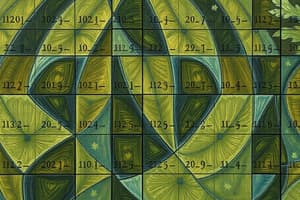Podcast
Questions and Answers
What is the associative property of multiplication?
What is the associative property of multiplication?
- The product is always equal to zero
- The product is dependent on the type of numbers used
- The order of the numbers affects the product
- The grouping of numbers does not affect the product (correct)
What is the distributive property of multiplication?
What is the distributive property of multiplication?
- The product is dependent on the type of numbers used
- The product is always equal to zero
- Multiplying a sum is the same as adding the products (correct)
- The order of the numbers affects the product
What is an array used to represent in the context of multiplication?
What is an array used to represent in the context of multiplication?
- A multiplication table (correct)
- A subtraction table
- An addition table
- A division table
What is the benefit of using arrays to teach multiplication?
What is the benefit of using arrays to teach multiplication?
What is an example of an everyday object that can be used to illustrate the concept of arrays?
What is an example of an everyday object that can be used to illustrate the concept of arrays?
Study Notes
Multiplication by Arrays: Properties and Patterns
In mathematics, arrays are a valuable tool for understanding multiplication. They provide a visual representation of the multiplication process, making it easier to grasp concepts like the commutative and associative properties. In this article, we will delve into the properties and patterns involved in multiplication by arrays.
Array Model
An array is a rectangular structure consisting of rows and columns. The number of rows represents the multiplier, while the number of columns represents the multiplicand. When we multiply, we are essentially counting the number of objects placed in each cell of the array. For example, if we have an array of dots, each row represents a certain quantity, and each column represents a different quantity. Multiplying these quantities gives us the total number of dots in the array.
Commutative Property
The commutative property of multiplication states that changing the order of the numbers does not affect the product. In the context of arrays, this means that the total number of objects stays the same regardless of how the rows and columns are arranged. For instance, consider a 3x3 array of dots. If we change the order of the dots, the total number of dots in each row will be the same. This property makes multiplication by arrays a powerful tool for understanding multiplication.
Associative Property
The associative property of multiplication states that the grouping of numbers does not affect the product. In other words, if we have an expression like a(b + c), where a, b, and c are numbers, the product will be the same regardless of how we group the numbers. Similarly, in an array, the order of the rows and columns does not affect the total number of objects. For example, consider a 2x3 array with dots. If we group the dots differently, the total number of dots will remain the same.
Distributive Property
The distributive property of multiplication states that multiplying a sum is the same as adding the products. For example, a(b + c) = ab + ac. In the context of arrays, this property can be visualized by adding the products of each row and column. For instance, consider a 2x3 array with dots. We can find the total number of dots by adding the products of each row and column.
Multiplication Table
An array can be used to represent a multiplication table. For example, a 10x10 array represents a 10x10 multiplication table, with the number at the intersection of each row and column representing the product of the corresponding factors. This visualization can help students understand the structure of multiplication tables and navigate them more easily.
Everyday Objects
Arrays can be found in everyday objects, making them a relatable and practical tool for teaching multiplication. For instance, a dozen eggs arranged in a tray with two rows of six eggs in each row can be used to illustrate the concept of arrays. Similarly, the grid arrangement of app icons on a smartphone or tablet can serve as a visual aid for teaching multiplication using arrays.
In conclusion, arrays are a powerful tool for understanding multiplication and its properties. They provide a visual representation of the multiplication process, making it easier to grasp concepts like the commutative and associative properties. By incorporating arrays into your teaching, you can help students develop a deeper understanding of multiplication and its applications.
Studying That Suits You
Use AI to generate personalized quizzes and flashcards to suit your learning preferences.
Description
Explore the concept of multiplication using arrays, including the commutative, associative, and distributive properties. Learn how arrays can help visualize and understand multiplication tables and everyday objects.




